#its such a cool template/archetype!!
Explore tagged Tumblr posts
Text
today specifically im thinking about alastor. im a casual critical vivzie viewer of both helluva and hazbin but ive never posted my fanart before since im not really interactive in the community at all? but i think i like the idea of drawing fanon alastor if anything. i love playing with that kind of character, id love to find more artists that draw fanon or more in depth details about what they imagine the character is like. i dont even care about canon compliant when i find a truly passionate artist that can cross reference similar medias with the same appeal, like it's really cool to find a crossover of two characters i like AND have compared... i want that
also, supplementary aesthetics or traits. its what id do with fanon darkiplier too. what objects or tools, styles, personality features, habits, living spaces, etc. would you assign to such a character to enrich the depth of flavor?
these character types are so fun and lovable for so many reasons, primarily horror abt ASPD/psychopathy/serial killers and the other appeal around that in a fiction/fantasy setting where it could overlap or depict a variety of other obscure identities ❤️
ofc no glamorization of the real counterpart of these media tropes, i honestly dont care for it aside for psychological cases that 90% of the time are not serial killers and rather just people like you and me who would like representation in media all the same. i honestly love characters who are autistic aroace aspd / DID and have some other social dilemma usually in fantasy where they are depicted as a whimsical or tidy villain somewhat? its a fun fictional way to depict their obscurity and "inhumanity" now thats a very acquired taste of mine I am aware not everyone enjoys antagonized depictions, but the way I engage with media is different lol
basically i like them somewhat cuz i resonate with them, even if they tend to be a stereotype—i think you can take that archetype and do it RIGHT, change some things around and make it more realistic and fun... BUT
i also like them cuz i dont relate to them- they are not just figuratively inhuman in the alienation/dissociation way that i experience, but also inhuman in a literal or allegorical terrifying way. so its not just a mirror, its like a fun horror character to scare u as well. its fun.
also maybe its more common than i think? im curious what other people like villains for, if it might be something similar to mine.
cuz i do think it has somehting to do with the philosophical questions and scary explorations into "worst person you could be" vs "best person you could be" taking that inner moral discussion of what you fear vs what you think you should be, and then confronting all the possible variables to show you the nature of the dilemma, painting morally grey characters and their experiences with the struggle in a more impossible fictional way that you shouldn't do IRL. it helps against mental illness in my opinion lol but only if handled properly by the viewer
thats a part of it but also i believe being a trauma survivor ontop of predisposition to my interest in horror, psychology, and gothic romance definitely adds more depth to what benefit i garner from those depictions of struggle and possible resolution.
#rambly and tired so i might delete later if it feels weird to read back lol but idk#basically me rambling and tired saying i wish more content with alastor-like characters existed#its such a cool template/archetype!!#idk if ill like the direction hazbin goes for alastor#i honestly enjoy vivzies stuff like 50-50 but 70 if i have no expectations haha
1 note
·
View note
Text


𓏵 A GUIDE TO SCRIPTING FRIENDSHIPS
──────────────────
YOUR FRIENDSHIP
┆what kind of friendship is it? is it chaotic, fun and full or adventures or deep and inspiring? maybe its just calm and supportive? maybe even a mix of all of these?
┆what do you want them to bring out in you? consider that if you script them to be really crazy and rebellious, you might turn out that way aswell. if you script them as calm and responsible, they probably wouldnt come with you to explore an abandoned hospital or shoplift some cute clothes
┆duo archetype examples golden retriever + black cat, chaotic + responsible, mom friend + menace
┆how long have you been friends? are you just gonna meet them for the first time and build up the friendship overtime or have you been friends for years and know each other really well already? if youve already known each other for a while, how did you meet them?
┆traditions maybe you get ice cream together every sunday, maybe you go for a trip every summer
┆hangouts what do you do together?
─ ─ ─ ─ ─ ─ ─ ─ ─ ─ ─ ─ ─ ─
THEM AS A PERSON
basic info template here
┆traits to script weird, interesting, selfless, creative, supportive, caring, sweet, open-minded, fun, funny, adventurous, understanding, silly, helpful, thoughtful, unhinged, deep, positive, loyal, empatchetic, shy, cool, patient, passionate, wise, trustworthy, generous, humble, brave, reliable, inspiring, authentic
┆general vibe are they loud and chaotic, deep and mysterios or soft and calm? a mix of all of these?
┆energy level are they hyper or more towards the calm and chill side?
┆skills you can script them to have any skills that might benefit you like them being a hairstylist so they can help you dye your hair or being super good at math so they can help you with your homework
┆hobbies
┆a fun fact maybe they hate mint gum, maybe they have a secret tattoo that only you know about
┆friendship love language do they show affection by hugging you, complimenting you, making you gifts or asking you to hang out all the time?
remember - scripting every small detail about their personality is not necessary, your subconciousness already knows what you like in people
you can use already existing people/characters as insipration
─ ─ ─ ─ ─ ─ ─ ─ ─ ─ ─ ─ ─ ─
THINGS TO SCRIPT
you guys dont have the same style (could cause fights while shopping)
theyre always getting you small but thoughtful gifts
they match your energy
they always have time for you
they always have interesting stories to tell you
they give amazing advice
you have a secret hangout that only you know about
they are very good at school and always willing to help you
they have the best taste in music, movies, shows, books, etc and introduce it to you aswell
─ ─ ─ ─ ─ ─ ─ ─ ─ ─ ─ ─ ─ ─
QUESTIONS TO HELP YOU DEVELOP FURTHER
describe your friendship in 3 words
whats your go-to activity together?
why are you friends?
whats your favourite memory together?(if you havent met yet, whats something you cant wait to do with them?)
how do you two balance each other out? are you opposites that attract or two peas in a pod?
have you ever gotten into a fight? why? how did you fix it?
how would they describe you?
do you guys have a shared secret?
do you go to the same school or maybe even work together?
do you guys have a shared dream? (ex: travelling to another country together or starting a busieness together)
whats their signature scent?
whats the craziest thing you have done together?
─ ─ ─ ─ ─ ─ ─ ─ ─ ─ ─ ─ ─ ─
SCENARIOS TO SCRIPT
you discover an undergroud club together
they surprise you with the tickets to your favourite band/artist
they make you a playlist and you go for a late night drive listening to it
going on a spontaneous road trip
you start a prank war (harmless of course)
sneaking out to go to a house party together
building a tree house
finding a stray animal and taking it home to raise it together
you start a yourube channel together
getting matching nails/hair/outfits
getting a job at the same place and working together
starting a podcast together
karaoke
─ ─ ─ ─ ─ ─ ─ ─ ─ ─ ─ ─ ─ ─
EXTRA
make them a playlist
make a moodboard for them/your friendship
design their house
script in a pet for them
write a story about one of your most memorable moments
#reality shifting#shiftblr#shifters#shifting#shifting antis dni#shifting blog#shifting community#shifting consciousness#shifting diary#shifting script#shifting ideas#shifts#shift#shiftingrealities#shifting realities#deminetly shiftblr#deminetly#things to script#scenarios to script#scripting#script#scripts
245 notes
·
View notes
Text
so for Marenrow: City of Secrets (my custom magic set), wren and i have made all of the two-color signpost draft uncommons except two (18 total!). the final two to make are for the white/blue draft archetype, and have proven themselves the most difficult to make, because the archetype is such a novel idea. id like to explain the archetype and how it would work in this post, and maybe anybody that is so inclined could think of and share ideas for the cards or tell me their opinion on the archetype itself :)
so the red/blue and white/blue color pairs are "working together" in my set; they are two separate groups of scientists and wealthy nobles/politicians respectively, and the scientists control the nobles (the red/blue group is in charge of the white/blue group, in essence). the theme of the red/blue group in Marenrow is flipping coins for value, and so i think it would be cool for the white/blue group, their followers, to flip coins too.
so, the white/blue group's archetype is "flipping coins to determine two related outcomes on their cards", or what in my head i refer to as "coin control". this means that every white/blue instant and sorcery has "flip a coin" before its text, and could do one of two different things based on the outcome. furthermore, white/blue creatures would have "when this enters the battlefield, flip a coin" and would do different things based on the outcome too. for permanents, it doesnt necessarily have to be an enter-the-battlefield thing, and could instead be on like, attack triggers, card draw, maybe two different static abilities and only one is activated at all times based on the initial flip, stuff like that.
the idea here is that for the two modes, one is usually interaction, and the other is usually value. or to generalize further, when you win the flip, it should harm your opponents, and when you lose the flip, it should help you. the idea here is that both modes are good, and this creates a novel form of card compaction; every card is both an interaction piece and a value piece, but you cant control which half you get. the random nature will be hopefully offset by the cards being generally strong, so either way you get good solid results when you cast the card most of the time.
this differs from the red/blue archetype, because red/blue will flip coins more often, will care more about winning flips rather than getting value from win or lose, and notably has cards with triggered abilities that trigger when coins are flipped or when coin flips are won, which specifically wont be the case for white/blue. white/blue does not care about the coin flips themselves, it just uses them as pure card compaction, while red/blue's entire thing is cards that trigger when coins are flipped.
heres the main question: is this a good idea? does this sound like a fun, interesting, and novel archetype of deck to play? furthermore, is this too similar to the red/blue archetype? are they not unique enough? id love some opinions on this. the answer is obviously "make some cards and try it out" but like. vibes alone, does this sound interesting, fun, and valuable enough to make cards for, or should i change it somehow, or scrap it altogether for a different concept?
furthermore, id love if anyone shared any ideas they might have for cards if theyre so inclined! the cards would be templated something like "flip a coin. if you won, [interact with you opponent]. if you lost, [do value (make tokens, gain life, draw cards, untap permanents, etc etc etc)]." to make the cards fun and cohesive, the cards should probably have related abilities for each mode, ie "if you won, tap two permanents an opponent controls" and "if you lost, untap two permanents you control" yknow something in that flavor and vibe. im blanking a little on ideas for cards, so if anyone is so inclined to share their thoughts, id love to hear it! most suggestions for the set have made it into the current product or future plans in one way or another, so its very worthwhile :)
thank you for reading my big long ramble teehee im glad to finally have put a lot of these thoughts into words
39 notes
·
View notes
Note
gayhorrorsansX3
Ask is irrelevant to this post:
CW:
Brief mentions of proshipping, the section will be highlighted in red so you know what to skip past.
Mentions of Unlust and therefore abuse, the mentions of abuse will be highlighted in purple
Mentions of SwapDream Dream Sans
Occasionally I'll see people express their dislike for sans OC's, which you are well within your right to. However every AU is an OC, even if they've been adopted by the fandom such as Swap, Fell and Lust (i think).
They are still OC's. OC's are so incredibly useful to keeping this fandom afloat. I understand you may have specific ones you dislike, I for one do not like Unlust, Yandereswap, Alphatale (although this is sort of a lie) and many others. Obviously the former two are both AU's of an AU, making an OC using the template of a pre existing OC. But every AU did that with Classic Sans anyways
My dislike of Yandereswap is not necessarily because it is a yandere AU, but the absolute destruction of it as a potentially interesting AU. The fallen stars are an absolutely barbaric take on the Stars and make absolutely no sense. Each person can interpret their AU as their own, so I will not harass or make fun of anyone who views them in a certain way, so long as you can acknowledge that them existing makes no sense. However the individual AU's themselves are interesting in a way.
YanSwap could have been interesting, though I find 99% of the time people do it, it has no reference to 'yandere' and is just essentially a Dust AU with a different motive. Also when he is a yandere its almost always with the protagonist(Chara) or his brother... SO YKNOW I'm not the biggest fan.
Obviously you can take the idea of an AU and change it to better suit the scenario you're putting them in as a writer/artist, and this doesn't mean anyone who uses yandereswap makes him fall in love with those two people, after all DustBerry exists. But seeing an extreme amount of content that paints an AU in a certain light can make you uncomfortable to work with the AU or just make you dislike it.
I have started to warm up to a yandereswap, even though I'm not really a fan of the yandere archetype anyway. I still hate Dustberry because of it. Sorry not Sorry.
Unlust is a complex AU with history with the fandom, and in itself is quite odd. I have researched, but do forgive me if anything I say is canon, turns out to be retconned/not canon at all. The fandom portrayed Unlust as being in an abusive relationship with Fell. <I wrote a whole section here about 10 times the length of this but I found it difficult to write down my true feelings on the matter without it sounding like I was justifying Fell's hitting of Lust (to my knowledge, Fell hit Lust once because he was mentally out of it because of a fight he had with Fell Papyrus.) This obviously doesn't justify it, but 'abuse' as a verb, must be repetitive behaviours. If Fell hit Lust every day, that could be classified as abuse, hitting him once is not. But again this sounds like I'm justifying Fell, which I'm not. They ended up getting together in canon (after a long thing with Dust, Nightmare and an alter ego) yeah uh, don't bother with it. If it makes it worse the creator shipped Chara x Sans(theyre not in the fandom anymore thats why past tense is used)
My dislike of Alphatale isn't because of anything specific, I just don't like omnipotent God OC's. I'm guilty of it as I had made one before. But an OC without flaw/ability to lose or be harmed to me ruins the fun. It's sad because I find the designs interesting. I love 404's design, I adore Infected's design. But I'm not the biggest fan of the AU. Also it canonically came before Undertale... which... how does an alternate come before the original? We'll never know. It is interesting, but I don't really like God OC's sooo yknow.
The thing with designs brings me to a certain... Swapdream dream sans. I adore his design, he looks so cool. But his AU... and creator... yeah uh, if you know... you know.
Anyway this got really off topic, regardless. AU's and OC's are the same thing here. I appreciate the work people put into AU's. It is okay to not like certain AU's, but if you say you don't like sans OC's you're being a bit odd. Like I know what you mean,
You don't like smaller AU's like Anxiety Sans, ADHD sans and so on.
However you don't give these smaller AU's a chance. So many cool AU's I've been introduced to in a certain server *cough cough* violet banquet. I wouldn't have been interested prior, but I'm slowly starting to warm up to the idea of these AU's people would call OC's.
So I guess uhh, just have an open mind. Don't shut it out because you already have enough, creation is a beautiful thing we have in this fandom, and seeing new OC design and art is so FUCKING COOL
I could have articulated some of my points better so pls forgive me
anyway, bye guys!
#gayhorrorsans#sans#sans au#sans oc#undertale#undertale au#lust sans#unlust sans#swapdream sans#swapdream#dust sans#nightmare sans#swap sans#yandereswap sans#writing#gayhorrorsans rant#gayhorrorsans ask#rant
19 notes
·
View notes
Text
Sonic the Hedgehog Yu-Gi-Oh, Heroes/Team Archetype
This is the first time I've posted anything like this, so wooooooooo flying bliiinndddddddd XD (And before anyone points it out, yes, I am aware of how silly the new Mobian typing is. This is mostly just me having fun XD) This is one of the first archetypes I made, primarily based on drawing out the chemistry in Team Sonic, Sonic Heroes-style. It also received SEVERAL overhauls since its creation XD
(full disclosure, I have no idea who made any of this fanart. Back in the day I kinda just grabbed anything that looked cool and saved it to my laptop because I didn't know if I'd be able to find it again. So my sincerest apologies to all the incredible artists who I unfortunately cannot credit here.)
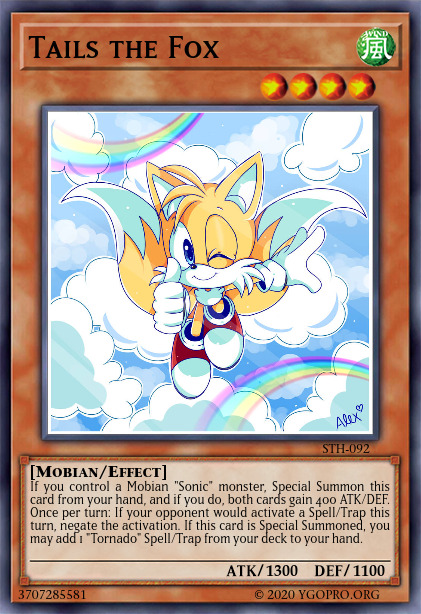


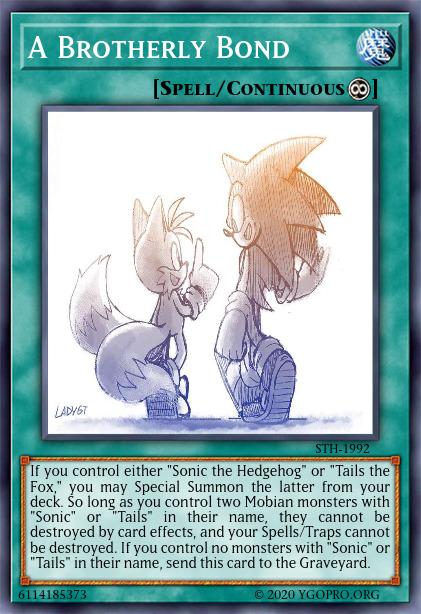






And a bit of a bonus here, and a slight foreshadowing of things to come!


I hope y'all enjoyed!
Since y'all are done looking at the cards above, I'll provide a bit of background for those who would like to hear.
About a year ago one of my friends decided to turn our friend group into Yu-Gi-Oh cards and helpfully linked the site.
I was in a YGO phase at the time and had just discovered that a large portion of the monsters and archetypes had LOOOOORREEEEE and that their effects actually lined up with it. You know, things like Gagagigo and Albaz.
So I decided to make some cards for one of my favorite things, Sonic! ...Then my friend made some cards. ...Annnd then I made some more cards. And we just kept going back and forth until I had made WAY more cards than I had originally planned to.
Then about a week ago I decided to look them over and compare them to my actual cards, and YIKES XD So many things were off. Wording, typos, whole effects that contradicted each other... so I decided to redo (and in some cases, completely overhaul) most of the cards I'd made.
And now I'm sharing them with you! I might also show off some of the cards my friend made if he's cool with it. He's a LOT better at making these than I am^^ I hope y'all enjoy and that this inspires you to make stuff even better than this! I mean, it shouldn't be too hard, right? XD
#sonic the hedgehog#sth#yugioh#ygo#card game#custom yugioh card#sonic#tails the fox#knuckles the echidna#sonic heroes#dark sonic#team sonic#technically fanart?
2 notes
·
View notes
Text
Welcome to Soylent Crocodile!
Hello! I'm Strawb of @strawberry-crocodile, a girl in her mid 20s with an unfortunate love of Pathfinder's first edition. I've spent about 10 years on and off homebrewing, with a particular focus on monsters and prestige classes. This is a place for me to share that content with you all!
Here's a tag guide; Feats, Spells, and Items- These first three tags should be pretty self explanatory; this category is for "smaller" character options, the kind of thing that's not as big a commitment and has less content. With a few exceptions, I'll generally be posting these in batches. Classes, Subclasses and Archetypes- This is my tag for the other player-side homebrew. It's for bigger stuff than the previous tag; archetypes, class options (like sorcerer bloodlines), and prestige classes. I have two homebrew classes made, but those are something for a milestone I think! Monsters and Races- At the moment I have races lumped together with monsters, but I may shift the system later. This is, obviously, for monsters, something PCs will generally not have access to as easily. Any setting- I have a homebrew setting with its own countries, organizations, and pantheon, and intend to also post content specific to Golarion. Most content, however, will be sorted into this tag. Expect tags for those settings as they come. Soylent Original- This is just a tag for all my homebrew content lumped into one, without reruns, feedback, discussions, or anything I post here that isn't just new homebrew. Soylent Talks- This is mostly for things that aren't Soylent Originals, such as answering acts, or this post!
Other, specific tags under the cut;
Cool Mounts- This is a tag for unusual Large-sized quadrupeds that were created with being ridden in mind, something I feel is underrepresented if you ask me. Phyrexia Project- This is for Phyrexian creatures specifically, with the intention being that you can run a full campaign using a combination of these homebrew creatures as the Completed race and Phyrexian template. Warhammer 40k- A collection of monsters and classes and lore written to adapt my current hyperfixation, Warhammer, to a previous one, Pathfinder Kaimere- Creatures taken from the Kaimere setting Serina- Creatures taken from the Serina setting I love cats- I love cats. Here are some cool big cats.
13 notes
·
View notes
Text
16: Twinkeyz // Alpha-Jerk
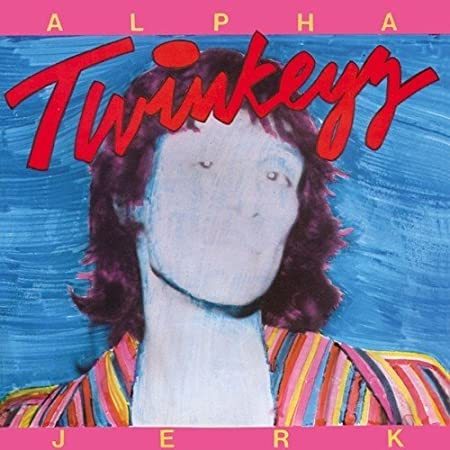
Alpha-Jerk Twinkeyz 1979, Plurex
The Twinkeyz were a late ‘70s Sacramento garage rock band orbiting guitarist/singer/songwriter Donnie Jupiter. They cut a couple of singles in '77 and '78 and the Alpha-Jerk full-length in '79. The LP apparently suffered from mixing and mastering issues, and it disappeared virtually without a trace, taking the band with it. Jupiter would spend some time in the late ‘80s and early ‘90s playing bass in the even more obscure act Lizards, while also building a career in comics under his birthname Don Marquez. The Twinkeyz’ faint legend lingered though; their debut single “Aliens in Our Midst” is a regular on gay punk compilations, and they’re occasionally cited as a forerunner of queercore acts like Pansy Division.
The Twinkeyz were a B-movie Velvet Underground, laconic, witty rock and roll sweatered in primitive synth warbles and (to quote Scott Miller of Game Theory) “enough guitar effects to stun an elephant.” The lead guitarist (presumably Jupiter) is often the only one who seems more than minimally competent, and (although the songs on Alpha-Jerk were drawn from different sessions) the mix uniformly sounds like it’s thudding from a blown speaker. If the choice to self-produce robs Alpha-Jerk of a professional sheen, they also get to do a lot of stuff most producers wouldn’t allow. Nearly every track is studded with odd noises and found sounds, giving it a hand-made texture that suits the peculiarity of the music.
youtube
As with Suicide’s Alan Vega, the thing that makes Jupiter’s blunt songwriting distinctive is that it feels like an indoor kid’s idea of cool teenage music. “Strange Feeling” approximates then-current new wave pop, but the flatness of its affect seems to imply having feelings at all is the strange part; “Sweet Nothing” pulls the archetypally dumb garage move of ripping off the title (and nearly the melody) of a more well-known song, like they were trying to recreate “Oh! Sweet Nuthin’” from memory after dad broke their copy of Loaded over his knee. The lyrics about love, UFOs, psychic powers, and cartoons are obviously cute, but sometimes a sick sense of humour peeps through. Referring to weird psych as “bad drug” music in a well-worn cliché, but it’s the right description of “Alpha-Jerk,” a discordant dirge that could be about a kaiju or the Book of Revelations. The noises in the mix resemble the work of a crow leaving shiny bits and bobs on a tombstone.
youtube
It's all very good stuff for anyone with a taste for wimpy garage rock, but “Aliens in Our Midst” stands hips and knees over anything else here. The lyric cleverly mixes yarns about literal aliens with uncharacteristically direct anecdotes about queers and weirdos who “turn out okay” despite shitty circumstances, creating an anthem that is sentimental, bleakly funny, and ultimately hopeful in the exact ratio I adore. The campy call and response vocals in the chorus, Plan 9-ass guitar tone, subtly counterintuitive riff… it’s the stuff abductions are made of.
16/365
Sidebar: Cartuneland.com, the bizarre website of Donnie Jupiter (AKA Don Marquez)
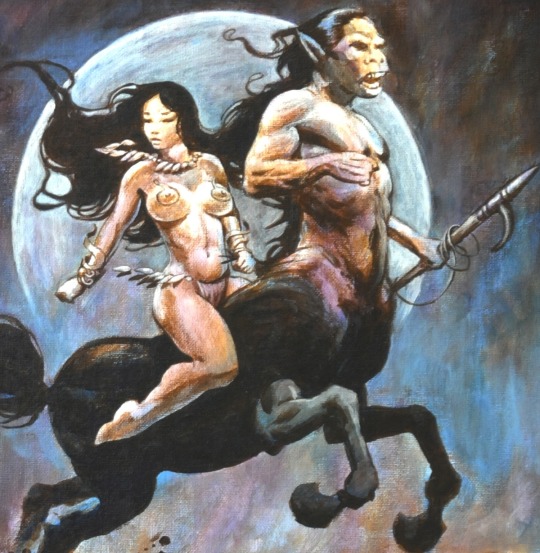
As noted, Jupiter/Marquez mostly switched to illustration after the collapse of the Twinkeyz, and he's still selling his art on eBay. His own site, Cartuneland.com, is bewildering and uncanny in the way webpages end up when a brand outsources its content management to an overseas SEO firm. Samples of his fantasy paperback-style art are interspersed with bland stock photography, and the structure of the site is clearly based on a corporate template—only Marquez isn’t advertising himself as a freelancer, and the site isn't connected to his eBay page. The contact and social links are variously empty or broken, and the links to his past comics direct to Wayback Machine-captures from an Angelfire-era version of the site the artist probably built himself.

Strangest of all is the blog which, shockingly, has two posts this month alone—both of them about the Bodhran, an Irish hand drum. Of the six total posts on the blog as of this writing, two of them are interviews with Marquez. The others are ChatGPT-quality posts about general topics in music (e.g. “Connecting literature to art”; “What is a tin whistle?”) and a peculiar first-person story about learning to play the flute, all credited to someone named Rachel George. The idea was probably to pad out the blog with keyword-laden content to help the site become more visible to search engines, but to what end? Is Marquez really all that bent on becoming the most visible hit on “Don Marquez music” or “Bodhran for beginners”? You wouldn’t be able to tell from the interviews, which feature terse answers from the former Twinkey, such as:
Q: Many of your creations are based on classic horror and sci-fi films from the 1950s.
DM: I wasn’t trying to be retro.
Q: What’s missing from the current cinema that makes old films so memorable?
DM: Horror is a broad genre. Horror is a vast genre.
What we’re looking at here is most likely a Fiver contractor’s unfinished attempt to turn Jupiter’s website into a place to sell his original art, but as it stands it’s an oddly perfect web presence for a 73-year-old garage micro-legend and purveyor of swords ‘n’ tits fantasy. If anybody finds Question Mark’s Livejournal, please drop a link in the comments. And Donnie, if you're reading this, get in touch and I will fix your website for cheap!
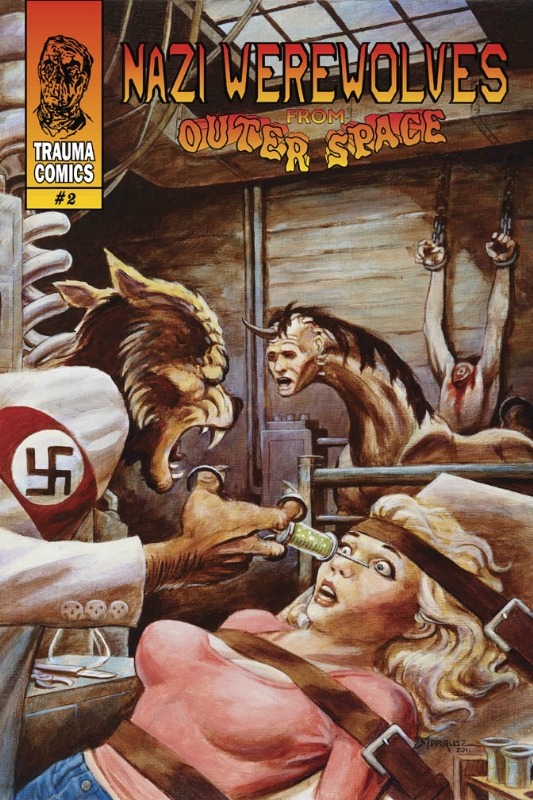
#music review#vinyl#the twinkeyz#donnie jupiter#don marquez#sacramento music#garage rock#psych rock#punk#aliens in our midst#queer punk#'70s music#'70s punk
4 notes
·
View notes
Text
So, I came to find this post from a sorta weird inflection point. Skip to "And this is the crux" if you don't want my rambling prelude.
I'm looking at building a new D&D character, and decided I wanted to do something different from my usual "Warlock, bending the rules over my knee as much as possible" approach. I started by picking an archetype, or rather, an Archetype feat(1), specifically "Anti-Communist Machine" but refluffed to be pro-communist, cuz... I'm pro-communist and I don't like playing characters who are counter to my principles (and the feat doesn't actually rely in any way on a relation between ideologies). It requires you to play a construct.
That's cool. I started looking at construct races, and found one or two that are about being a construct that represents an idealized form of the creator's species, which led my AuDHD brain to think "Character that looks like "what if soviet propaganda, but by goblins. Or lizardfolk, or whatever." Which is a fun thought. I think, anyway.
It meant trying to research that particular artistic style, to get a feel for it, and therefore, how it might depict its subjects if it was made by a fantasy race.
The thing about Socialist Realism... well, there are two things. The first is that it is a reaction to and builds upon other artistic styles. The second is... well, there's a reason why Soviet and Nazi propaganda have similar visual aesthetic styles. Socialist Realism is, first and foremost, a Realism based style. Which I don't think is inherently a bad thing. Which is why I kinda just said "...um, ok, whatever" when I first saw explainslowly's response above and moved on.
But as I started sketching out "Socialist Realist Statue Goblin," I realized that... well, Socialist Realist Goblin would be incredibly generic. Like... that's sort of the point of socialist realism, or rather, the overarching term that encompasses both the Soviet and Nazi visual aesthetics, Heroic Realism. The idea being to present the artist('s sponsor)'s chosen demographic in an idealized, perfect, form. And the thing about "Perfect Forms" is that... if you diverge at all from the template, it's no longer the Perfect Form. Like, to take it out of direct political ideologies for a moment, if you decide that Arnold Schwarzenegger's body is the Ideal Perfect Form, then even a perfect replica who happens to be blond instead of brunette is no longer Perfect. By definition. So, Socialist/Heroic Realism Goblin would have to be The Platonic Ideal of a Goblin. Which means you have to figure out what goblins would see as their idealized form in light of their standards of beauty. But also, if you step away from "Muscular, thin, young, and chiseled" then it's no longer recognizable as Socialist Realism. Which means that you have to focus on the things that mark a goblin as visually distinct from a human. Which means leaning into, well, creating what would look like a an antisemitic caricature, except as done by someone who thought the antisemitic caricature was the ideal form. Which... is weird. A kind of an interesting thought exercise, but as a catholic-raised, considered-white-in-America, never-been-Jewish artist... it's not one I personally want to explore.
But, ok, so let's say you want to take the thoughts and ideas that gave rise to Heroic Realism, and then apply that to goblins. You still have to figure out what goblins would see as the physical ideal, and what they would see as "degenerate/bourgeois."
And this is the crux.
While the Soviets did not frame things as "degenerate," their artistic ideas come from the same place as Hitler, the idea that anything which strays from visual realism is bad and harmful to society, except that realism must always depict the decreed perfect form. It is the idea that impressionism is evidence of a diseased visual cortex. It is the idea that only someone who is physically and mentally degenerate could produce art that isn't the decreed style.
I don't necessarily think the Chobani ad is trying to do this kind of propaganda. It's more focused on "a sustainable, ecofriendly future includes our products." Which is of course a laughable and in its own way bad thing to peddle. That said, I think realism is perfectly fine as an artistic style. But I get why explainslowly sees the ad and its artistic style, whether with the corporate elements, or those elements removed, is promoting a pernicious ideology beyond "buy our stuff." It's leaning into artistic tropes which have been used to that pernicious end in the past.
...which... I guess is the same problem some people have with goblins. Huh.
-------
1 a feat category on dnd-wiki for feats that describe who your character is and give scaling benefits as they level up
247K notes
·
View notes
Text
Shadowless Shadowdancer - CR8 Humanoid/Undead
This vampire has a shadow.
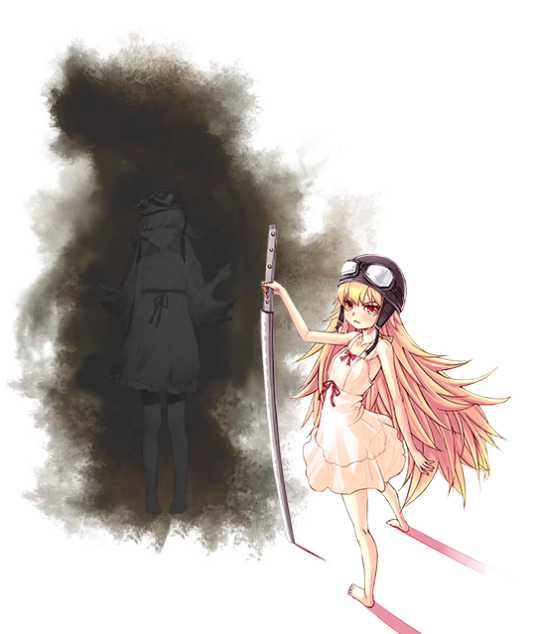
Artwork is a combination of art by Reason on Pixiv, art by lowercasek on DeviantArt, and art from D&D 3e by Wizards of the Coast.
Sorry for the double-multiclassed character with three archetypes and a template, but I had a very specific idea of what I wanted to do with this creature, and was determined to do so within the rules for once.
The artwork for this NPC is based on Shinobu Oshino, a vampire character from Monogatari, but the NPC’s powers really don’t have much to do with that character. I just wanted to make a shadowdancer. The NPC Codex and d20pfsrd don’t have a lot of NPCs with archetypes or prestige classes. And the idea of a vampire shadowdancer, who doesn’t have a shadow, but whose shadow disguises itself as her shadow, is just so cool. I ended up making the character a dhampir instead of a full-fledged vampire, though, not because of balance or flavor reasons, but just because it didn’t need any more special abilities.
NPCs don’t normally get traits, but she has a single drawback trait, so she gets a single beneficial trait to make up for it. The drawback trait causes her to have no shadow, like a vampire.
Outside of combat, her shadow stays in the ground as an incorporeal creature, but takes the shape of her shadow on the ground’s surface and matches her movements.
Shurikens have the monk special quality and can be used with flurry of blows, but her katana doesn’t. She can create a light monk weapon such as a siangham using Umbral Gear and make a flurry of blows with that, but there’s rarely a reason to do so instead of using shurikens or unarmed strikes. These attacks usually just do 1 nonlethal damage (which is what happens when an attack’s damage gets reduced to 0 by penalties), but most of her damage comes from sneak attacks and Prey On Fear. When performing a flurry of blows, she can spend a ki point to gain a fourth attack.
In combat, she often begins by charging an enemy to gain her sneak attack, using punishing kick to knock them backwards, and then activating her Quick Runner’s Shirt to back away. If an enemy moves up to her, she attacks them once and then uses Fast Getaway to escape. Once her Quick Runner’s Shirt is used up, she primarily attacks from range with flurries of shurikens. When escaping, she uses her Slippers of Scampering to run up the walls if possible. Her shadow companion acts as a front line tank while she runs around.
The shadow companion doesn’t give its own XP - it’s factored into the Shadowless Shadowdancer’s challenge rating and XP already, like an animal companion.
Shadowless Shadowdancer - CR 8
The girl seems like a normal human at first, neither armored nor carrying a single piece of equipment, and wearing only a sun dress - until she draws a weapon out of her own shadow. And then the shadow itself rises up from the ground, still bearing her image.
XP 3,200 Young dhampir, kishu + scout ninja 4 / hungry ghost unchained monk 1 / shadowdancer 4 CE Small humanoid (dhampir) Init +8 Senses darkvision 90 ft., low-light vision; Perception +21
DEFENSE
AC 27, touch 22, flat-footed 20 (+6 Dex, +1 dodge, +4 mage armor, +4 monk, +1 natural, +1 size) hp 46 (1d10+8d8) Fort +4, Ref +14, Will +6 (+2 vs. disease and mind-affecting) Defensive Abilities evasion, uncanny dodge
OFFENSE
Speed 30 ft. Melee +1 ghost touch effortless lace katana +16/+11 (1d6+7/18-20) or flurry of blows unarmed strike +13/+13/+8 (1d4-3) Ranged flurry of blows mwk shuriken +16/+16/+11 (-2) Special Attack flurry of blows, ki pool (3 points), punishing kick (3/day), scout’s charge, sneak attack +2d6
Spell-like Abilities (CL 4th; concentration +5) 2/day—silent image (DC 14) 1/day—shadow conjuration (DC 15), shadow duplicate (see text) 40 ft./day—shadow jump (see text)
STATISTICS
Str 4, Dex 22, Con 10, Int 8, Wis 18, Cha 13 Base Atk +7; CMB +3 (+13 with katana); CMD 27 Feats Dodge, Mobility, Punishing Kick, Slashing Grace (katana), Weapon Finesse, Weapon Focus (katana, shuriken) Traits Reactionary, Umbral Unmasking Skills Acrobatics +18, Bluff +6, Disable Device +20, Intimidate +15, Linguistics +3, Perception +21, Perform (dance) +6, Sense Motive +10, Sleight of Hand +10, Stealth +18, Use Magic Device +6 Language Common, Necril SQ stern gaze, umbral gear Gear +1 small katana, effortless lace (applied to katana), mwk small shuriken x50, amulet of natural armor +1, headband of inspired wisdom +2, quick runner’s shirt, slippers of scampering, wand of mage armor (23 charges; already used), wand of inflict light wounds (15 charges), concealed weapon sheath, concealed shuriken pouch
SPECIAL ABILITIES
Umbral Unmasking (Ex) The shadowless shadowdancer casts no shadow whatsoever. Typically, when not in combat, her shadow companion disguises itself as her shadow, hiding this fact. Creatures that succeed at a DC 15 Wisdom check in normal light notice the strangeness of her shadow (an additional Perception check may be required based on environmental conditions). This telltale sign of wickedness cannot be concealed by misdirection, nondetection, or illusions, except those that also affect shadows (such as invisibility).
Vampiric Empathy (Su) The shadowless shadowdancer can communicate with bats, rats, and wolves as if under the effects of a speak with animals spell. In addition, she gains a +2 racial bonus on Diplomacy checks when dealing with these animals. The animals begin with a starting attitude of indifferent.
Negative Energy Affinity (Ex) Though a living creature, the shadowless shadowdancer reacts to positive and negative energy as if she were undead—positive energy harms her, while negative energy heals her.
Resist Level Drain (Ex) The shadowless shadowdancer takes no penalties from energy drain effects, AKA negative levels, though she can still be killed if she accrues more negative levels then she has Hit Dice.
Unarmored AC Bonus (Ex) While unarmored and unencumbered, the shadowless shadowdancer gains a bonus to AC and CMD equal to her wisdom modifier. These bonuses to AC apply even against touch attacks or when she is flat-footed. She loses these bonuses when she is immobilized or helpless.
Hide in Plain Sight (Su) The shadowless shadowdancer can use the Stealth skill even while being observed. As long as she is within 10 feet of an area of dim light, she can hide herself from view in the open without anything to actually hide behind. She cannot, however, hide in her own shadow.
Flurry of Blows (Ex) The shadowless shadowdancer can make a flurry of blows as a full-attack action, giving her one additional attack at her highest base attack bonus. She must make these attacks using any combination of her unarmed strikes and weapons that have the monk special weapon quality (such as her shurikens, but not her katana).
Ki Pool (Su) The shadowless shadowdancer has a pool of 3 ki points per day. As long as she has at least 1 point in her ki pool, she treats any Acrobatics skill check made to jump as if she had a running start.
By spending 1 point from her ki pool as a swift action, she can do one of the following: Make one additional attack at her highest attack bonus when making a full attack Increase her speed by 20 feet for 1 round Give herself a +4 insight bonus on Stealth checks for 1 round
Prey On Fear (Su) Whenever a shadowless shadowdancer deals sneak attack damage to a shaken, frightened, or panicked opponent, she adds +4 precision damage to her first successful attack that she makes against that opponent each round.
Scout’s Charge (Ex) Whenever the shadowless shadowdancer makes a charge, her attack deals sneak attack damage as if the target were flat-footed. Foes with uncanny dodge are immune to this ability.
Shadow Duplicate (Sp) Once per day as an immediate action when the shadowless shadowdancer is hit, she can create a single shadow duplicate of herself, as per mirror image. The GM randomly determines whether the attack hit the shadowless shadowdancer or the shadow duplicate. The shadow duplicate lasts for 4 rounds or until dispelled or destroyed. This ability does not stack with the mirror image spell.
Umbral Gear (Su) As a standard action while in an area of dim light or darkness, the shadowless shadowdancer can coalesce wisps of shadow into a quasi-real, functional item. The shadowless shadowdancer must choose whether to make a crowbar, 50 feet of silk rope, a glass cutter, a light melee weapon with which she is proficient, a reversible cloak, thieves’ tools, or a wire saw.
The shadowless shadowdancer can use such items for 14 minutes per day. This duration does not need to be consecutive, but it must be used in 1-minute increments. An item created with this ability remains until the shadowless shadowdancer is no longer touching it, or until she runs out of duration for this talent, at which time it dissolves.
Punishing Kick (Ex) When attempting an melee attack, three times per day, the shadowless shadowdancer can attempt to perform a punishing kick. If the attack is successful, it deals damage normally and the shadowless shadowdancer can choose to push her target 5 feet or attempt to knock them prone. A DC 18 Fortitude save negates being knocked prone. The save DC is Wisdom-based.
Shadow Jump (Sp) The shadowless shadowdancer can travel between shadows as if by means of a dimension door spell. The limitation is that the magical transport must begin and end in an area with at least some dim light. The shadowless shadowdancer can jump up to a total of 40 feet each day in this way. This amount can be split among many jumps, but each one, no matter how small, counts as a 10-foot increment.
Shadowless Shadowdancer’s Shadow
CE Medium undead (incorporeal) Init +2 Senses darkvision 60 ft.; Perception +8
DEFENSE
AC 19, touch 15, flat-footed 16 (+2 deflection, +2 Dex, +1 dodge, +4 mage armor) hp 23 (3d8+6) Fort +6, Ref +10, Will +3 Defensive Abilities incorporeal, channel resistance +6 Immune undead traits, turn undead, command undead
OFFENSE
Speed fly 40 ft. (good) Melee incorporeal touch +9 (1d6 Strength damage) Special Attacks create spawn
STATISTICS
Str —, Dex 14, Con —, Int 6, Wis 12, Cha 15 Base Atk +7; CMB +9; CMD 22 Feats Dodge, Skill Focus (Perception) Skills Fly +11, Perception +8, Stealth +8 (+12 in dim light, +4 in bright light); Racial Modifiers +4 Stealth in dim light (–4 in bright light) Languages Common
SPECIAL ABILITIES
Strength Damage (Su) A shadow’s touch deals 1d6 points of Strength damage to a living creature. This is a negative energy effect. A creature dies if this Strength damage equals or exceeds its actual Strength score.
Inherited Abilities (Ex) A shadowless shadowdancer’s shadow has a number of hit points equal to half the shadowdancer’s total. The shadow companion uses the shadowdancer’s base attack bonus and base save bonuses.
Linked Death (Su) If a shadow companion is destroyed, or the shadowless shadowdancer chooses to dismiss it, the shadowless shadowdancer must attempt a DC 15 Fortitude save. If the saving throw fails, the shadowless shadowdancer gains one permanent negative level. A successful saving throw avoids this negative level. A destroyed or dismissed shadow companion cannot be replaced for 30 days.
5 notes
·
View notes
Text
I think dedede is very popular but not everyone’s personal blurbo since
A-Dedede is very unusual since he doesn’t have “cool rival” vibes like meta knight, Goofy or egotistical characters (who aren’t gag characters) aren’t very popular in tumblr
B-certain types of villains like the big king who sits on a throne and has a army aren’t very popular in general, you would be surprised how few fandoms in tumblr actually talk about that type of villains if the villains aren’t the best of the story. Specially since dedede might be peak character design but usually fandoms prefer the villains/characters who resemble the main character in design (for example, meta knight who’s a template for OC’s far more versatile than DDD) and designs like the big bad guy who does shockwaves when falling to the ground or have a suction breath attack aren’t very popular in fandom’s
C-Magolor and Marx fit the “redeemed and not-redeemed villain” roles for the fandom, since Magolor did far worse than Dedede and had its redemption in this generation unlike Dedede who had that redemption around two decades ago and modern audiences haven’t really seen a game with evil dedede (their only present evil dedede being the anime version who’s completely different to modern dedede and has completely changed the king’s modern perception for ages) and marx who’s the usual trickster jester archetype everyone loves and comes off as the more archetypical Kirby villain (treacherous, cute but can be creepy, similar to Kirby in design philosophy) although I don’t know about Taranza being more popular, I like the guy but there’s no way he’s more popular than DDD
For example villains who aren’t the dark rival are usually ignored by fans UNLESS something brings attention to their characters since some people just don’t like characters who have a villain esthetic or vibes (like Eggman who took him having two kids, two lackeys and a husband for the tumblr fandom to care more about him beyond him being there obligatory for the fanfics since he’s the only recurrent villain in the series) of course it could just be under exposure like bowser who just needed more people to look at the spin offs for people to understand the character beyond being the dragon keeping the princess in the castle which is all he is in most mainline games (with the exception of Sunshine in which he only appears for like a hot minute before the game ends), with dedede the problem is the spin offs since most speaking appearances the king gets (kirby battle royale for example) is usually with him as a bad guy who resembles the anime counterpart more than the modern games, which is super weird since even smash pushes the idea of a dedede who’s a nice good guy but still has that “Videogame king final boss” vibe to him
Dedede is just such a anomaly in a Videogame franchise fandom since he’s not evil anymore like his fellow Nintendo antagonist kings (K. Rool, Ganon, Bowser, King boo) but unlike other redeemed villains he hasn’t changed visually or lost any of his power, and he’s always there as a boss despite other villains being the final boss
I personally think all needed to change dedede’s image and popularity is for time to pass with more games like forgotten land showing dedede’s character, some spin offs with dialogue showing dedede as a good guy, and maybe something like a Kirby animated series that shows the modern interpretation of Dedede to a speaking medium
Is it just me, or is King Dedede shockingly less popular in the Kirby fandom than one from the outside would expect?
I've not gone crazy, have I?
Like, don't get me wrong, he is popular and widely recognized, but in terms of popularity within the Kirby fandom (not counting outside the fandom, he does have some outside popularity thanks to Smash Bros) I can't help but notice that he falls short compared to Meta Knight, Magolor and potentially even freaking Marx and/or Taranza?
Well... I dunno about the latter two, but MK and Magolor absolutely appear to have a lot more stand-alone fans in the Kirby fandom than Dedede does. It's kind of surprising, really, because I would've thought that Dedede would've been more up to par with them than he seems to be.
It honestly makes me sad. Dedede was my original blorbo in the Kirby series. I still really love him even now, absolutely my favorite of the main squad aside from Kirby himself. And I just can't help but think he's been sort of shafted in the fandom?
111 notes
·
View notes
Link


"Only a few understand adventurers. Most consider us insane driven by treasures, ancient secrets, fame, admirers, power, or what comes to mind. It couldn't be farther from the truth." /Adbjorn Haig/
Enter the cruel and savage world of Atlas, where the ruins of forgotten civilizations are desecrated as the strange bones of the past begin to stir. Dark rituals mixed with corrupt technologies animate the ashes of the dead. As bloodthirsty hordes of barbarians and beasts alike roam the plains, the stern land can never be satisfied by the sweat and tears of the innocent. Mighty despots pass the time with their concubines behind high stone walls. Metal and magic have formed the land, erected floating islands, and twisted the deadly mountain paths. Take all you can before others plunder everything in this land of limitless possibilities! Rise as a mighty warlord or rot away like a maggot! Join us in the world of Atlas right here, right now!


"I have seen many shitholes on my voyages." /Feth Col/
Atlas – Rise or Die is a classic, vintage sword & sorcery tabletop RPG. In its style and mood, Atlas brings about the renaissance of the epic RPGs of the '80s with a modern, clean design and breath-taking illustrations.

If you are interested, don't wait! Get a sneak- peek of the layout right now! Come and look at how we imagined the book's design and the base of the 2d10 system!
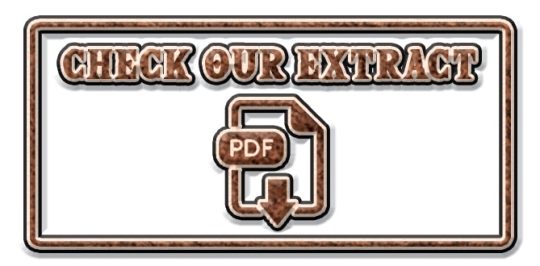
https://drive.google.com/file/d/1-e7_UOnNPa2cGsnwsowr55X9J2tFIPu1/view
The campaigns are housed in a brand new, progressive system that facilitates fast-paced and fluid gameplay. The system rests on the following seven main features:
A realistic, d20 compatible 2d10 system with low numbers. We believe that by using the result of rolls with 2d10s, we can eliminate some of the radical distribution of values often associated with d20s. This makes "Nat20" rolls even more epic and memorable, since their chance decrease from 5% to 1%.
We use a three-dimensional (race, class, archetype) character creation system, where by removing the traditional "alignment" aspect of characters and introducing the archetype system, well-rounded personalities can be created and played out.
The Atlas system allows for completely free character advancement, even maxing out a single stat is possible, though not encouraged by the system. It favors balanced characters and allows unique combinations of strengths and weaknesses.
Subsystems for NPC interactions, that allow overcoming obstacles by not only violent means. These make social interactions and investigations as enjoyable and manageable as combat encounters, resulting in immersive role-playing.
The XP system supports actual role-playing, not only combat.
The combat system is fast-paced and not roll-heavy. Alongside customary mechanics for damage distribution, it also emulates the dynamic physical positioning of combat participants. Combat maneuvers, boosts, and the decisions made in a fight scene this way become a fun activity instead of brainless rolls and damage calculation. Aiding our teammates and getting them in position come with substantive strategic rewards.
D&D 5th Edition compatible Setting on a brutal, bloodied, barbarian world of ancient technologies and dark rituals

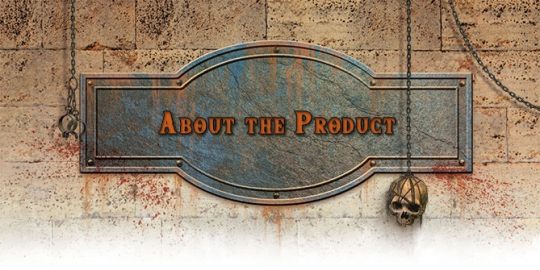
“A great sword consists of three parts. You grab the grid, you defend with the middle and you kill with the point. It can’t be simpler.” /Adbjorn Haig/
Frankly speaking, ATLAS- Rise or Die, is not one but THREE unique books merged into one revised and united volume.
The first part is the Corebook which contains the basics of the game. This includes descriptions, explanations, added tables, and examples. All the presented sub-systems represent one, merged system that can be used as a core for any alternative games. It is with 5th Edition and with d20 system also compatible.

The second section is the Player's Handbook. This contains detailed information for players to create their character through the Handbook's unique 3D character creation system. Roles, Races, paths, highlighted classes, and much more are included in this book. Everything listed above serves the ultimate purpose of exclusive character creation to ensure that each player generates their unique character that is entertaining and cool to play with.
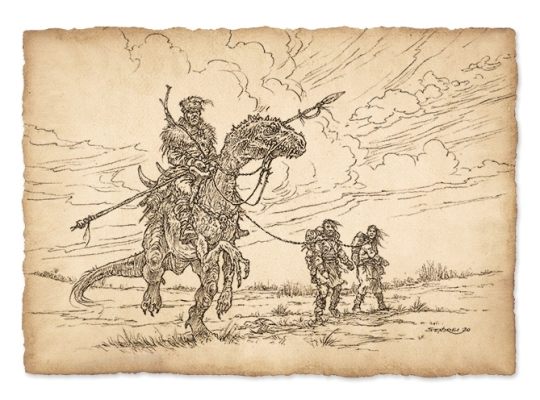
The third and last book is called Setting, which presents the wonders and dangers of ATLAS, a description of places, creatures, and everything that can be found on this barbaric land. It is full of adventures bringing you forgotten treasure, ancient monsters, and thrilling legends. The descriptions in this edition contain all the information a player needs to survive this brutal world. It is also "5th Edition-friendly".


All this will be brought to you in an old-fashioned hardcover book with the following parameters:
Hardcover, straight spine book
Classic portrait A/4 size
Matte art paper- core pages for stunning looks and to be easily readable

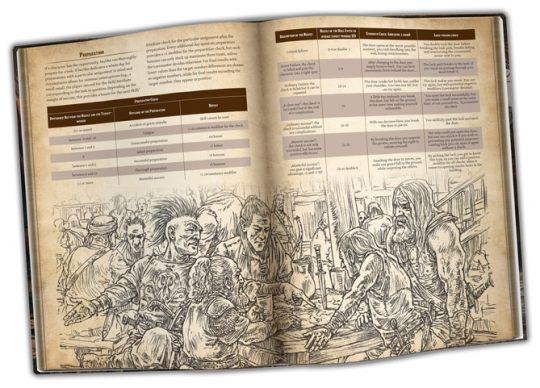
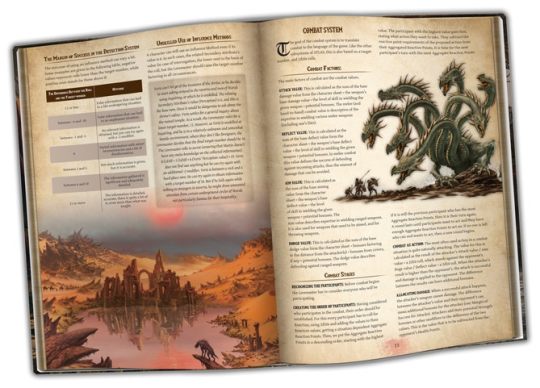
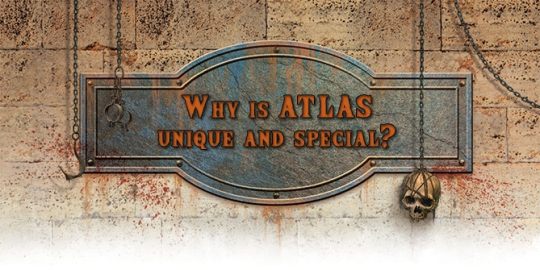
"When Enoon, our Dark Sun, arises, it shakes the calm waves of magic with its power. At such times, numerous disconcerting events manifest themselves all over Atlas." /Magister Athan/
Atlas – Rise or Die is more than another boring remake. Our goal is to bring back the atmosphere of classic game sessions in a unique new format, never seen before, through a completely modern, fresh, and trendy gamebook.
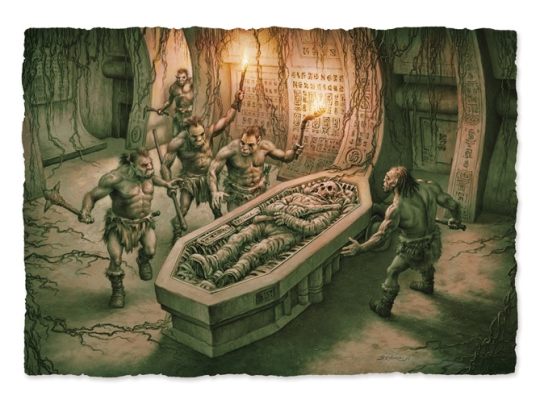
We are aiming to evoke a retro, vintage feeling with our design, all the while using high-quality, contemporary graphics, that would not have been possible in the ’80s.
Our own 2d10 system is less random and unpredictable than the classic d20, but it offers the same ease when it comes to calculation and keeping track of events. By using two ten-sided dice, average rolls are more frequent and exceptional rolls, like natural 20s, even more valuable - but is with D&D 5th Edition compatible.
We were adamant to retain as much as we can from the proven template of classic sword & sorcery RPGs while adding a few twists to make them better suited for the brutal world of Atlas. Our elves for example are sickly, degenerate nobles who rule their people through intrigue. Their savage relatives are bloodthirsty head-hunters, protecting their ancient forests and hunting down all intruders. The dwarves are tyrannical conquerors at the head of an enslaved populous, dwelling in underground fortresses, that they call cities. They often make deals with subterranean creatures only to have their aid in their territorial clan wars.
The fast-paced, narrative, and tactical combat system goes a lot further than the classic, "attack roll–damage roll" format. The combat maneuvers infused in attacks alongside the collected bonuses make combat less hectic, more enjoyable, and realizable.
It is not only the lovers of fight sequences who can find something to please them. We have developed influence and intuition systems to support non-combat situations, which give flexible frameworks for meaningful interactions, information-trade, and realizing player goals through NPCs.
In the world of Atlas, everything is about brutality and blood sacrifice, and so it is with our magic system. It is optimized for coming up with unique combinations, while it supports the creation of your own spells. Magic twists and drains its user, should they become too greedy, the price could easily become their lives.

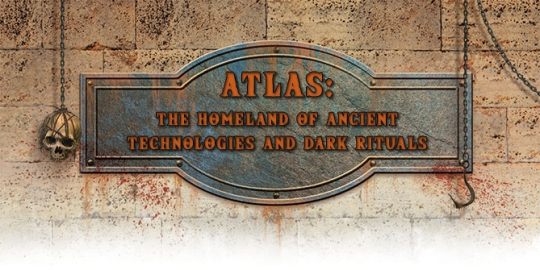
“Atlas is a cruel violent world, where barbarism, blood, and brutality dominate. But it wasn't always like that... A long time ago, ancient civilizations, advanced races, and rich kingdoms ruled this world, using their magic and technologies, rather than cold steel and muscle power.” /Magister Athan/
ATLAS is much more than a simple sword and sorcery world. It was shaped by barbaric realms, ancient monsters, and pioneer spaceships from forgotten civilizations.
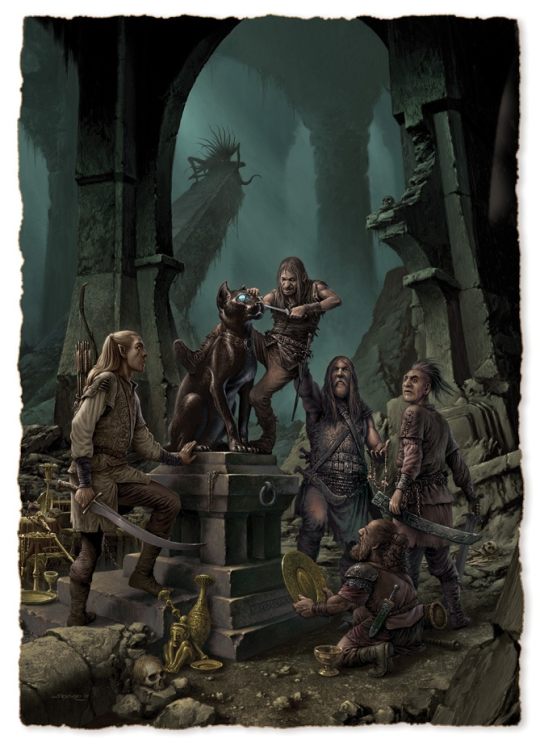
Kickstarter campaign ends: Thu, June 24 2021 11:00 AM BST
Website: [Old Mages Games] [facebook] [instagram]
17 notes
·
View notes
Text
Star Wars and the Space Opera
In 1941, a writer by the name of Wilson Tucker coined the term: ‘Space Opera’, used to describe what he called the “hacky, grinding, stinking, outworn space-ship yarn”. This derogatory term followed in the footsteps of words like ‘Soap Opera’, a familiar term used even today, and ‘Horse Opera’ a less-used word referring to a cheap western.
However, in the years following this initial term creation, the words ‘Space Opera’ soon became associated with a different connotation.
Today, well, we’d probably call it ‘Soft Science Fiction’.
The term ‘Space Opera’ as we know it now refers to a story set in an unfamiliar galaxy, full of space faring civilizations with access to wonderful technology that isn’t terribly important to the story. Space Operas are epics, action/adventure stories spanning solar systems and galaxies, full of political intrigue, romance, huge space battles, sprawling empires and planets, and larger-than-life heroes and villains playing out the age-old good vs. evil conflict.
The total opposite of hard science fiction, Space Operas are concerned with characters and stories, rather than how the warp-drive works. In the years since its original examples in the days of Buck Rogers, the term has lost nearly all of its negative connotations. No longer looked down on, many writers and moviemakers have come to embrace the Space Opera. Science fiction author Brian Aldiss even wrote a poem describing the steps that every self-respecting Space Opera must take in order to be an example of it’s subgenre:
The world must be in peril.
There must be a quest,
And a man or woman to meet the mighty hour.
That man or woman must confront aliens and exotic creatures.
Space must flow past the ports like wine from a pitcher.
Blood must rain down the palace steps,
And ships launch out into the louring dark.
There must be a woman or man fairer than the skies,
And a villain darker than a Black Hole.
And all must come right in the end.
There have been plenty of Space Operas in recent media history, ranging from the Dune novels to television shows like Battlestar Galactica or Star Trek. However, easily the best known and most recognizable example of a Space Opera ever created is obvious: George Lucas’s science fiction epic from 1977: Star Wars.
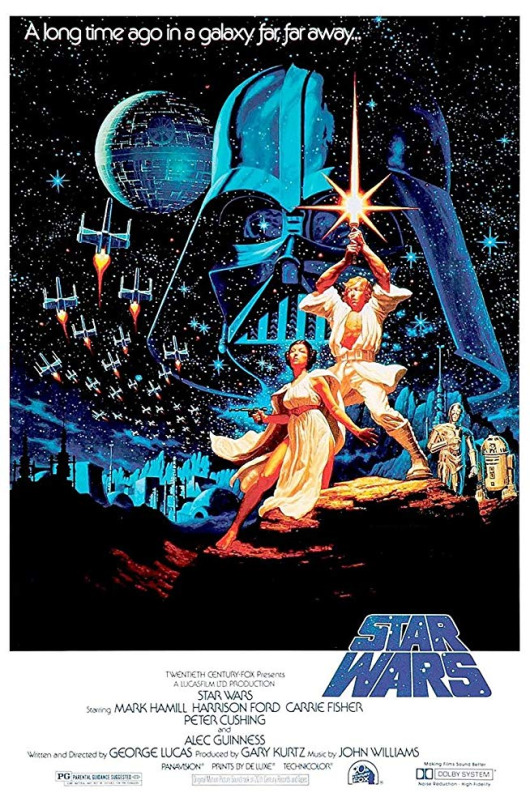
Star Wars was more than a film. Like Star Trek, it was a cultural phenomenon, sweeping the world immediately and paving the way for stories like it to find success in the future, as stories either inspired by it or intending to cash in on it were created in the years following. While hailed as the start of a renaissance of Science Fiction in film, it was more accurately the start of the Space Opera in modern popular culture. While set in space, the film states its scale firmly from its opening words: A long time ago, in a galaxy far, far away…
Star Wars wasn’t concerned with telling a story about science or logic. It was a story about heroic rebels rising up and fighting back against an evil empire. It was about big H heroes, Cool Starships, and Saving the World. Star Wars was the shift in connotations for the Space Opera. It was Star Wars’s thouroughly ‘space fantasy’ nature that changed the term ‘Space Opera’ from an insult to simply a genre.
As such a game-changer, it bears some discussion.
Star Wars was the template used in countless science-fiction films after it, whether outright copied by films like Starchaser: The Legend Of Orin or spoofed in films like Spaceballs, creating a series of characters, scenarios, locations, and technology that has inspired multiple stories since it’s release over forty years ago.

The fact that Star Wars has become such a codifier of Space Operas makes a lot of sense, considering that it almost follows Aldiss’s poem to the letter. While it does put an entertaining, fresh spin on a lot of fantasy and science fiction conventions, it doesn’t stray from those conventions. In fact, it embraces them.
Hence our discussion.
Today, we’re going to be analyzing the 1977 film Star Wars in the context of the Space Opera, using Brian Aldiss’s poetic criteria above to analyze how George Lucas, whether knowingly or not, managed to create the perfect Space Opera, starting with, of course, point number one:
The world must be in peril.
To start, let’s look at the opening crawl. Spoilers below!
It is a period of civil war. Rebel
spaceships, striking from a hidden
base, have won their first victory
against the evil Galactic Empire.
During the battle, Rebel spies managed
to steal secret plans to the Empire’s
ultimate weapon, the DEATH STAR, an
armored space station with enough
power to destroy an entire planet.
Pursued by the Empire’s sinister agents,
Princess Leia races home aboard her
starship, custodian of the stolen plans
that can save her people and restore
freedom to the galaxy….
The story of Star Wars begins in an era of galactic unrest. The evil Galactic Empire rules with an iron, tyrannical fist over the planets under it, squashing attempts at resistance, but stubbornly, the Rebellion fights on. However, even their attempts are hopeless in the face of this new weapon: the Death Star.
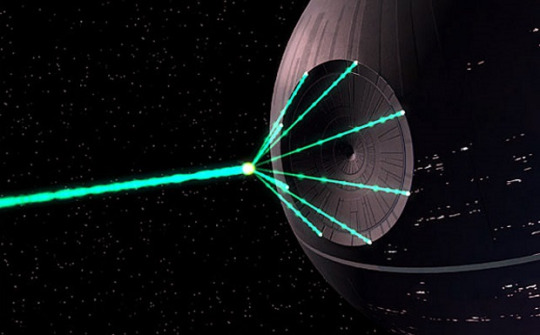
The stakes for the story are established immediately. By introducing the idea of a weapon powerful enough to destroy a planet, the audience, themselves only confined to one planet, immediately understand the threat that this weapon holds. Billions of people extinguished in one shot, and the people with the only hope to stop them are on the run, in danger.
It looks grim for the galaxy.
At the beginning of Star Wars, it’s the End of the World as We Know It, and it’s not just an idle threat. The Death Star is fully operational, and we see its effects as it destroys the homeworld of Princess Leia, Alderaan. Billions of people are destroyed instantly, and the weapon won’t stop there.
The galaxy is definitely in peril, and in order to prevent its destruction, the heroes must obliterate the weapon first, which, of course, answers our next line:
There must be a quest.
The quest is twofold. The immediate quest is a small-scale one, a quest as old as fairy tales: rescue the Princess.

After Princess Leia is captured by the Empire, she sends the plans for the Death Star, and a message pleading for help, in a droid, R2-D2, trying to get them to an old Jedi Master, (The Mentor and Wizard of the story) Obi-Wan Kenobi. Unfortunately, the droid (along with fellow robot, C-3PO) end up in the hands of farmboy Luke Skywalker. Luke, recognizing the name, takes them to the Jedi, and ends up whisked away, determined to rescue Leia. As he finds out more and more, the second part of the quest, the larger one, becomes clear: Destroy the Death Star.
In order to prevent the destruction of the Rebellion, Luke must go on a journey, traveling through interesting places, all while learning the secrets of the Jedi: a power known as the Force. Throughout this journey, he learns and grows, becoming better equipped to complete his quest along the way. As Luke passes through criminal-infested cantinas, the Death Star itself, and the Rebel base on Yavin 4, he gains new understanding and perspective, all while focusing on his main goal: Rescue the Princess.
This version of The Quest storyline falls under the ‘Overcoming the Monster’ quest, a single-minded one focused on the end goal of the story. Rather than focusing on a series of smaller quests that tie into the large one, the story of Star Wars revolves around the final act, with the characters pushing to Rescue the Princess and destroy the Death Star. It’s concise, simple, but solid enough to work, propelled forward by the characters in the narrative.

The Quest directly overlaps with the famous Hero’s Journey narrative, seen in countless stories on the page and screen. The combination thereof gives us a story where the focus is on the Hero’s growth and development as Luke finds his destiny, reacting to events pushing him forward, all while striving towards the end goal of the story. It’s a very compelling narrative, traditionally done as a fantasy story, which naturally makes it perfect for the standard Space Opera story.
Which brings us to our next point:
And a man or woman to meet the mighty hour.
Of course, the man of the hour in Star Wars is farmboy Luke Skywalker, whisked up seemingly by accident into this world of Jedi, Evil Empires and Rebellions. As with most Space Opera/Epic heroes, he isn’t terribly complex. There are no moral struggles for Luke Skywalker, he knows what he has to do, and with determination, he strives for it.
In many ways, Luke Skywalker is the quintessential Hero archetype. When we first meet him, (stage 1 of the Hero’s Journey), he is living on a desert farm that he desperately wants to get away from. He craves adventure, excitement, and information about the father he never knew, constantly badgering his aunt and uncle for a chance to leave the planet Tatooine.

Luke is a big H hero, good and pure, bent on achieving his goal. He’s an archetype, as old as stories themselves: the Ideal Hero, determined to finish the quest, stop the villain, and rescue the princess. He’s new to the galaxy at large, serving also as the audience surrogate as the other characters explain and teach him about the more mysterious elements of the galaxy, but he proves a quick learner, also able to (clumsily at first) wield the powerful Force to assist him in his quest. He even inherits the lightsaber (the science fiction equivalent of a sword) of his father, further adding to his Knight in Shining Armor role in the story.
Despite his good qualities, Luke isn’t perfect. He’s inexperienced, and naive. He’s a good shot with a blaster, and a better pilot, but he has problems with patience and anger, and has to be reigned in by other members of the cast. He also doesn’t always get along with everyone else on his team, as evidenced by his arguments with reluctant partner and Lancer Han Solo.
Oddly enough, Luke’s motivation to start this journey is mixed. While it would seem like he must want to Jump at the Call, when initially offered the chance for this adventure, Luke turns it down, citing his aunt and uncle as reasons not to go. Unfortunately, the Empire, in search of the droid in Luke’s possession, burn down his homestead, killing his aunt and uncle in the process. With nothing left of his home and family, Luke embarks on the adventure he seems to have always wanted, being pushed into the role of unexpected Hero.
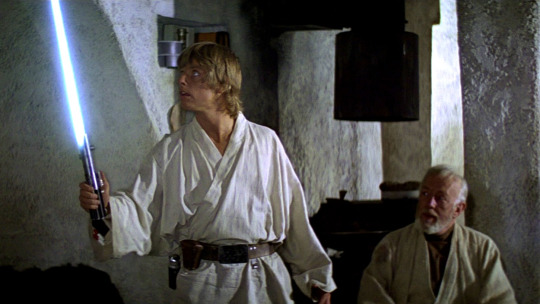
While initially starting the story in a role akin to The Load, it doesn’t take long for Luke to go through some Character Development to rise to his full potential. When dragged into the belly of the beast, trapped within the Death Star where Princess Leia is being held, it is Luke who assembles a plan, convincing the pilot who brought them, Han, and his copilot, Chewbacca, to assist him in rescuing Leia and escaping the Death Star. Later on, it is Luke who exploits the Fatal Flaw of the Death Star design, destroying the weapon and saving the galaxy (for now).
Throughout his Hero’s Journey, Luke inevitably fulfills the next part of our criteria:
That man or woman must confront aliens and exotic creatures.
While most of the characters are examples of Human Aliens, not all of the beings in this galaxy are. Good Space Operas tend to have interesting aliens to populate the planets the characters travel to, further spicing up the environment.
For Star Wars, one need look no further than the cantina sequence in Mos Eisley. The scene is filled with odd looking creatures, some of which even assault Luke. Earlier on, there are the Jawas, a species of scavengers who are responsible for C-3PO and R2-D2 ending up in the hands of Luke in the first place. But both of these examples are minor in comparison with the token alien of the team: Chewbacca.
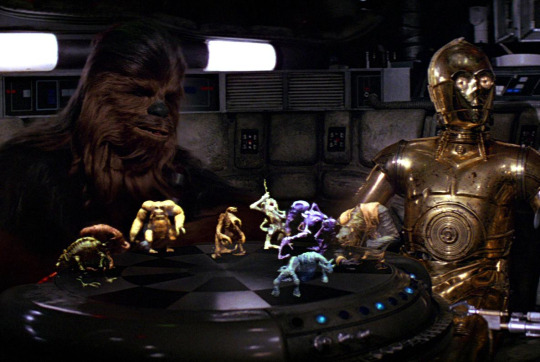
Chewbacca is Han Solo’s copilot, and a Wookiee. Large, furry, and unintelligible, Chewbacca’s contribution is invaluable, being the decoy prisoner, and the Big Guy of the team. The Bruiser with a Soft Center Mr. Fixit, Chewbacca is presented as more than an alien, but a character who happens to be a different species as the rest of the cast. He serves as a constant reminder of the ‘otherness’ of the galaxy, a constantly present ‘exotic’ creature to drive home the Space Opera atmosphere. As the co-pilot and mechanic, it is also part of Chewbacca’s job to keep the iconic Millennium Falcon running, and fly her when Han is needed in the gun turrets.
Speaking of the ships:
Space must flow past the ports like wine from a pitcher.
The galaxy is a big place. In order to move the plot forward, the characters need to get around, fast. Unfortunately, space is so large that characters would likely die of old age before reaching anywhere interesting, so a faster method must be developed.
The problem of slow space travel has long been ‘fixed’ in science fiction stories since the ‘60s, with Star Trek’s warp drive being a prime example. In Star Wars, a similar idea is used: that of the hyperdrive.
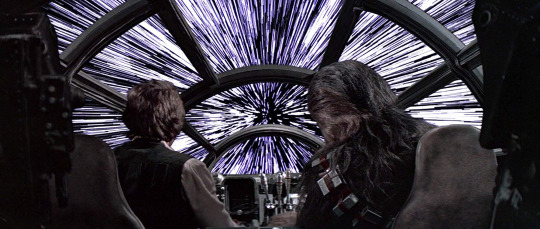
In order to get anywhere, the ships in Star Wars travel faster than light, enabling them to hop from location to location speedily, as well as engage in high-speed chases and dogfights. Indeed, it is due to this that the Death Star is such a threat. Being able to travel quickly, it could destroy multiple planets that much faster.
Using the hyperdrive, the Millennium Falcon is able to travel from Tatooine to the ruins of Alderaan, to Yavin 4 quickly, adding to the urgency and allowing the characters to keep moving. As useful an invention the hyperdrive is, though, there’s more to the use of speed in space than just travel.
Star Wars ends, not with a sword fight or shootout, but with a dogfight.
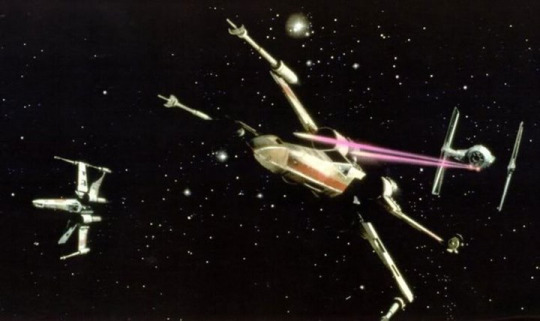
The battle of the Death Star is a tense action sequence making up the climax of the film, reliant entirely on the forces of the Empire (flying TIE fighters) versus the Rebels (flying X-Wings and Y-Wings). The fast pace and high stakes combine to make a tense ride, and an unforgettable ending. Neither the Death Star trench run, nor the escape from Tatooine would be possible without the Handwave to physics, but in a Space Opera, it doesn’t matter.
All of this talk about stakes leads us right into the next line:
Blood must rain down the palace steps,
Victory does not come without a price.

Throughout Star Wars, lives are lost. Owen and Beru, Luke’s Aunt and Uncle, are the first notable victims, although the death toll is surprisingly high. Princess Leia’s entire planet is wiped out with one blow. Obi-Wan Kenobi is killed, sacrificing himself to allow Luke and the others to escape the Death Star. And the final Death Star trench run ends with a victory for the Rebel Alliance, but only after all but three of their ships (and pilots) are killed. These deaths are not without purpose within the narrative, demonstrating the severity of the Empire’s threat, as well as serving as reminders that more peoples’ lives are at stake. These horrible events push our heroes on, forcing them to always consider the cost as friends are lost.
There may not be a palace, but there certainly is bloodshed.
And ships launch out into the louring dark.
Spaceships, like mentioned above, are absolutely essential to the quintessential Space Opera. They are beyond forms of transportation, they are characters in their own right. From the Empire’s menacing Star Destroyer to Han Solo’s beat up freighter, each ship has its own unique look and ‘personality’.

Star Wars coded it’s ships in a very specific way. The Empire’s ships are shiny and sharp. They are grim and foreboding, all greys and blacks, well-put-together and dangerous looking. From the tiny TIE fighters to the imposing Star Destroyers, the Empire’s fleet is both foreboding and numerous, a frightening force pitted against the small Rebel Alliance.
The Rebellion ships, on the other hand, look a bit different. From the Tantive IV vessel to the tiny X-Wings, the ships of the good guys look a little more worn down, a ragtag assembly of ships that are utilized to the best of the Rebel’s ability to fight the Empire. The X and Y-Wings are small but fast, evocative of our own fighter planes, bringing home the imagery of the space-dogfight.
But no ship says ‘personality’ like the Millennium Falcon.
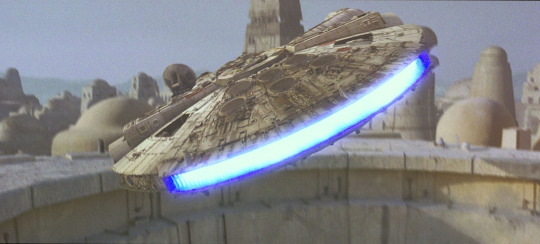
The Millennium Falcon is, to quote Luke Skywalker, a ‘piece of junk’. She looks awkward, clumsy, cobbled together, and at times, she doesn’t seem to work all that well. The ship is easily recognizable, with a unique design, and she seems to have a personality of her own. A faithful ship, despite her flaws, the Millennium Falcon is fast, very fast, and maneuverable. It is her speed that makes Obi-Wan and Luke choose to hire Han and Chewbacca to pilot them, as the Falcon turns out to be quite a match for TIE fighters, and is able to outrun the Empire’s forces. It is Han and Chewbacca flying this trusty hunk of junk in for a last-minute rescue that enables Luke to destroy the Death Star, cementing the Millennium Falcon as a ‘Hero’ ship. In fact, it’s the Falcon’s speed that made a lot of the rescuing possible. Speaking of which:
There must be a woman or man fairer than the skies,
This one depends on how attractive you find Han Solo, but in the story proper, the ‘fairer than the skies’ part seems to land to Princess Leia, the Damsel in Distress who is the one giving the quest in the first place. However, Leia is a subversion of the typical Damsel and Quest Giver character, as being a leader in a Rebellion, she is no stranger to battle, and once rescued, takes charge, and gets in on the action. Leia is beautiful, and it is remarked upon by Luke, but her royal station and her position as a prisoner does not stop her from being a Royal Who Actually Does Something, and is quick to take up a weapon to help fight her way out of the Death Star. In the end, she is the beautiful Quest Giver, but Damsel in Distress? Only slightly.
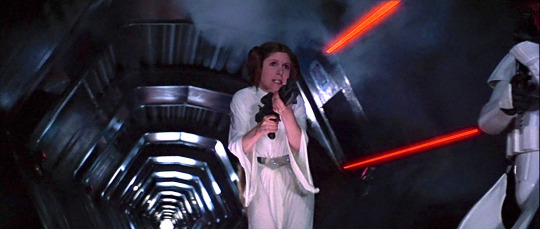
But we can’t talk about heroes, quests and battles without talking about the other side.
And a villain darker than a Black Hole.
Every Epic story needs a villain, and the bigger, the better. The Dreaded Evil Overlord is a staple of the Space Opera genre, the very epitome of villainy. In the case of Star Wars, thankfully, the villain bases are covered.

Besides the overarching evil that is the Empire in general, there are specific villains in the story for our heroes to overcome. Grand Moff Tarkin, a cunning, proud military leader, is in charge of the Death Star. He orders the destruction of Alderaan, and is a cold-blooded killer, also willing to terminate the captive Princess Leia. He presses in on the Rebel Base with the Death Star, intending to wipe them out, and it is his pride and arrogance that keeps him from being concerned about his superweapon’s fatal flaw.
Despite how horrible Tarkin is, he is not our villain ‘darker than a Black Hole’. That would be, of course, Darth Vader.
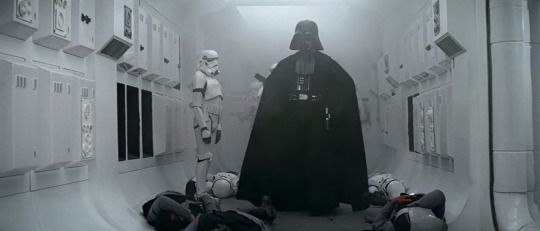
Darth Vader has long been heralded as one of the greatest villains of all time, and with good reason. With an iconic, unique look (dressed head to foot in black armor, with a mask obscuring his face), Darth Vader, much like the rest of the Empire, is unquestionably evil, the epitome of darkness to contrast with Luke’s light. Despite the fact that Tarkin commands the Death Star, Darth Vader’s power is greater.
Like Obi-Wan, Darth Vader is also a Force user, but one who uses its power for evil. It is Darth Vader who tortures Leia for information (which she resists), and Darth Vader who strikes down Obi-Wan in the Death Star. He is a foreboding enemy, and his skill with the Force, the lightsaber, and as a pilot is a triple threat to the Rebels. He also plays a large part in the Death Star trench battle, picking off many Rebel pilots and nearly finishing Luke off as well. Only Han Solo’s last-minute entry into the battle stops him, sending Vader careening off into the galaxy, defeated, but not destroyed.
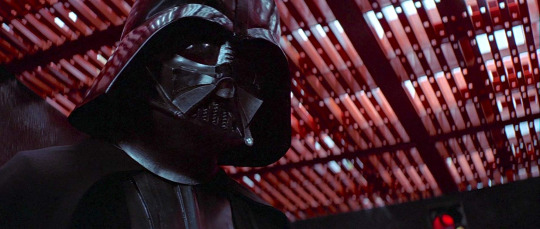
Unlike most variations of the villains of Space Operas, Vader does not stick close to his base. He ventures out, actively hunting down and destroying the Rebels. He commands his officers, but seems to answer to the Emperor himself, setting up the idea that he may not be the Evil Overlord he seems to be (revealed to be the case in later films). Darth Vader is incredibly dangerous, however, cunning and powerful, and it is telling that, at the end, he is not destroyed with the Death Star, but merely taken out of action for the time being, indicating that he will return.
But although Darth Vader isn’t entirely vanquished, the day is still won.
And all must come right in the end.
Although Luke’s family is gone, Leia’s planet destroyed, Obi-Wan dead, most of the Rebel Fleet destroyed, and Darth Vader still out there, there is still a Happy Ending. The Death Star has been demolished, proving that the Empire is not invincible, and Grand Moff Tarkin has gone with it. The Rebel Alliance survives to fight another day. Luke Skywalker has found his destiny and become a hero, pulling together his band to do so. Han Solo managed to find a selfless side, joining the fight as well. Leia has been rescued and can return to helping lead the Rebellion’s fight against the Empire for the future. There is a New Hope for the galaxy.
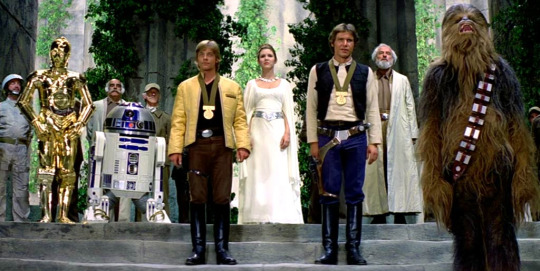
Star Wars, like most Space Operas, is an idealistic story. The villains are defeated, the heroes are triumphant. Good wins over evil. It’s a good ending, a happy ending, well-earned by our heroes.
The ending doesn’t feel saccharine, either. It is a hard-won victory, and many lives have been lost. It is an against-all-odds victory, one not without cost, but thanks to the courage and sacrifice of people who believe in freedom, the Rebellion has a fighting chance, and the Empire is that much closer to destruction. It’s a Happy Ending, and more importantly, it’s the right ending, perfectly matching the tone and characters of the rest of the film.

Star Wars is not about how the hyperdrive works, or the technology required to build the Death Star. It’s not about how humanity contends with it’s own creations, or how we live in a technologically advanced society. In fact, it’s not really about ‘humanity’ at all. It’s just about people.
Star Wars is a fantasy epic set against a backdrop of stars, set a long time ago, in a galaxy far, far away. It’s about good vs. evil, about the defeat of tyranny. It’s about a heroic farm boy, a rogue smuggler, and a brave princess. It’s about heroes and villains, magic and battles. It’s a fairy tale.
All of the above comes together to make Star Wars the definitive Space Opera. Every point is perfect, every element in place, so much so that it seems paint-by-numbers. But it’s not.

Star Wars relies on tropes that are almost as old as stories themselves, but it all feels fresh and new. By developing interesting worlds, compelling characters, and a moving conflict, Star Wars managed to rise above the standard, taking the term ‘Space Opera’ and turning it into a defining subgenre, rather than an insult.
Star Wars single handedly changed a genre thanks to its earnest storytelling and characters, proving definitively that Tropes Are Not Bad, and that any story, no matter how ‘old’ it is, can still be made something fresh and beloved.
Don’t forget that the ask box is always open for anything from suggestions and discussion ideas to questions and conversations! Thank you guys so much for reading, and I hope to see you guys in the next article.
#Movies#Film#Science Fiction#Sci-Fi#Fantasy#Action#Adventure#Star Wars#Star Wars 1977#70s#A New Hope#A New Hope 1977
80 notes
·
View notes
Text
thinking of writing my “what i would do if i was asked to make the next star wars trilogy” idea into a fanfic.
Story idea rant below
So its a good 40/50 years since episode 9.
The galaxy is back in war, because of course it is. However, this time it is not a simple “evil imperial sith dudes” vs “democratic jedi nice guys” instead its between 4 morally complex groups:
The republic, who has been a bit too imperial recently in fear, ironically, of a new sith/imperial group rising in power.
Pros: Democracy is nice :)
Cons: Shadowy politics and fear-mongering has led to questionable policies
A so far unamed group formed from the rebelled stormtroopers and other ex-imperial groups and systems. defiant against the republics new iron grip they eventually rebelled fully. Mandalorians joined these guys
Pros: Cool imperial-rebel hybrid aesthetic. mandalorians
Cons: Some less cool imperial militaristic ideologies.
A group that split from the republic to serve their own interests. A largely capitalist group made up of shareholders and trade corporations led by kaminoans, who have “perfected” cloning to create archetypal dna templates for any role
Pros: Not actually that cruel or expansionist
Cons: eugenics basically, spooky dudes
The criminal underbelly whos no longer so “under”. no longer content with just running a few outer ring systems, several cartels and gangs united to claim more territory.
Pros: No law fun times. Western aesthetics. Tattoine
Cons: No laws bad times. Western ideologies. Tattoine
What makes this war different however, is the Jedi. As always when shit hit the fan the republic turned to Rey, who had begun her own jedi temple. Rey however learnt from the clone wars, and vowed no jedi would ever again have the title “general.”
Instead, she took her jedi and left, finding neutral, unknown systems to work from. Instead of serving the republic they serve peace and life. They got involved with the war sure, but only in helping refugees and enforcing fair play. stopping slave trade and production of death star level weapons. They encouraged and watched over peace talks, but never took sides when they deteriorated. This led to a pretty cruisy time for those systems not in the war. no blockades if you refused to join, or a jedi would come and kick your ass.
However, the war raged on despite their best efforts. So Rey (old but not decrepit thanks to force shenanigans) hatches an egg. i mean a plan.
She goes to each of the four factions home systems, and finds a force sensitive child of similar ages. She trains all four to be jedi, but allows them to return home each summer. She hopes this will allow them to be positive influences on their factions, and to be the key in returning the galaxy to peace.
These become our four main characters.
Gonna flesh this out more, name things and characters. But basically the first “movie” would be their jedi knight test, where they have to protect a primative city built on an ancient sith temple that the four factions just discovered and about to start fighting over. plot ensues.
3 notes
·
View notes
Text
Haven't finished fully yet but here's some facts about vic (thank you ren for the template!)
:readmore:
General
Full Name: Victoria Sakamaki
Reason for name:idk yet
Nickname: Vic
Reason for nickname: its short and nice : )
Age: 40-years younger than the sakamakis
Sex: Female
Gender: Woman/baddest bicth
Place of Birth:
Birthday: 16/11 (16th of November)
Currently living in: The Sakamaki house
Species/Race: Pure blood vampire
Ethnicity: Kinda complicated cause she grew up in the us so has has a cultural connection with the human world rather than the demon world.
Blood Type: A+
Occupation: Moderator of her sister's twitch chat if that counts
Sexual Orientation:Bisexual
Social Status: She's Richter's daughter so i guess that makes her royalty?
Relationship Status: Single (has had 4 past relationships)
Status: Alive and kicking (but not thriving)
Appearance
Body Build: inverted triangle with a SNATCHED waist and LEGS oh boy shes got some legs
Height: 175cm
Weight: idk yet but shes toned
Skin colour:
Hair style:
Hair colour: Light blonde
Eye colour: Blue
Distinguishing Features: yo she got that chiseled jawline and wide shoulders
Preferred Clothing: Simple but elegant (chinos pants with square buckle belts , turtlenecks and silk buttons ups/tops, jeans .Usually she combines monochrome pieces together.)
Accessories: Her accessories are minimal and simple looking (gold chains , hoop earrings, etc)
Health
General health: She's healthy : )
Posture: Always amazing
Any physical illnesses?: No : )
Any mental illnesses?: Yes : (
Take drugs?: She might have a joint or do a line of coke from time to time but nothing crazy or regular.
Smoke?: Lmao yeah everyday
Mental/Emotional State
Archetype:
Mental age: 22 college gay frat bro that's like "yassss lets get fucked and crazy tonight bro" and 44 year old depressed dramatic lesbian widow that murder her rich husband for his will "no officer i don't know what happened to my husband " at the same time
Act before thinking/Think before acting?: Always act and talk before thinking , she has no filter
Emotion-wise, generally: She's unexpectedly good at reading the emotions of others and helping them open up idk how , this bitch is dumb as fuck
Conversation
Way of speaking: She will call you a bro and a darling in the same sentence, it's hard to explain she has that slow "Yes, darling" elegant way of speaking but also will also say shit like "Ayato, babe, stop being a cunt."
Common conversation starter: "What?"
Swears?:All
Made-up words?:no
Made-up language?:no
Likes/Dislikes
Likes:
Dislikes:
Hobbies
Habits
Strengths/Weaknesses
Strengths: Good at getting her shit together and fixing situations when nobody else will. Cares a lot about family. Honest. Apart from being a violent when provoked she doesn't lose her composure under stress. She's good at helping others open up about their trauma/emotions and can pick on when others are pretending to feel ok. Only gives advice for things she's been through and when she does it's actually pretty good. She know how to fill taxes.
Weakness: Has no filter, gets provoked easily, doesn't avoid violent confrontations , doesnt't try to de escalate situations , shes also an asshole and can be very rude. She will not pretend to like somebody just to avoid negative interactions. Very apolitical and tries to avoild anything that has to do with her social status and political power of her family.
Skills/Abilities
Education/Intelligence
Education:
IQ: 69
EQ: 420
Secrets
Fears
Dreams/Goals
Just finding happiness one day.
Views/Opinions on...
Government: Mostly apolitical with human politics, pretends karlheinz doesn't actually exist
Religion: doesn't really have an opinion
Economy: is aware that she had class privilege but doesn't think about it too often
Technology: She thinks it's cool
Favourites
Food: black pepper chips, grilled unagi eel
Colour: gold, deep red, sapphire
Animal:Small dogs
Number: 8
Holiday: doesn't really have one
Season: doesn't really have one
Time of day: 8pm
Thing to watch: shitty reality tv
Movie: idk yet
Show: idk yet
Type of art:
Genre of music:
Genre of literature:
Genre of shows:
Genre of movies:
History
Personality
Relationships
Family:
Love interest:
Friends/Allies:
Enemies:
Quotes
"Is that the little white twink you were talking about?'
Trivia
3 notes
·
View notes
Note
Might as well get this out of the way... RWBY is Disappointing and Here’s Why: thoughts?
No interest. I guess I’ve mostly heard that hbomberguy is good, but I don’t care to listen to 2+ hours about how a thing I like is bad actually; I’ve gotta exceptionally despise something to care to listen to that about something I hate. Plus from what I’ve heard he spends most of it talking about the first two seasons not working, and that along with the Faunus allegory ultimately spinning into extremely dicey respectability politics are my main issues with the series anyway, so why spend the time going “I already know this and agree with it, but it brings me no pleasure to hear it reiterated”? Pretty much every complaint I’ve seen about it from assorted corners of the internet in the last year or so that I started paying attention falls anyway into either those categories, or anime nerd nitpicking about power scaling/disagreeing with plot decisions or character motivations/not seeing for the forest for the trees regarding character development, so I just don’t really care. This is something where I’m mostly content to just enjoy the thing on my own rather than taking up the banner of defending it from all comers.
everythingsucksbutthatsokay said: I want to like RWBY, but it just has not grabbed me any of the times I’ve tried to start it. The character designs and fight choreography are awesome, but the characters and storyline just don’t hook me. What is it about the show that made you keep watching?
I’m not surprised it hasn’t grabbed you, because I’m gonna hit you with what’s apparently considered a Hot Take among the longtime RWBY fan community: those first two seasons ain’t very good, which is a situation only tenable because they’re only a couple hours apiece and still breezy enough fun. I only started watching it because I heard “Hey, Marguerite Bennett, who I quite like, is doing a miniseries for DC based on that internet kinda-anime I’ve seen references to and a couple cool fights from on Youtube. Well, it’s free online, what the hell”,* and it was exactly good enough to occupy my attention on the treadmill watching it on my phone without caring enough yet to switch to my laptop. It isn’t until season 3 that the plot seeds and character threads start to come together into something really engaging (and not until season 4 that they switch from the original extremely dated visuals to the current graphics system, even if the choreography from the early parts still holds up), but once it did I unexpectedly found myself profoundly taken with it.
* And then of course the last physical issue of that was cancelled due to the cornoavirus comics industry hiatus; I, a dope, will get the trade, because I liked it and I want it all in one format.
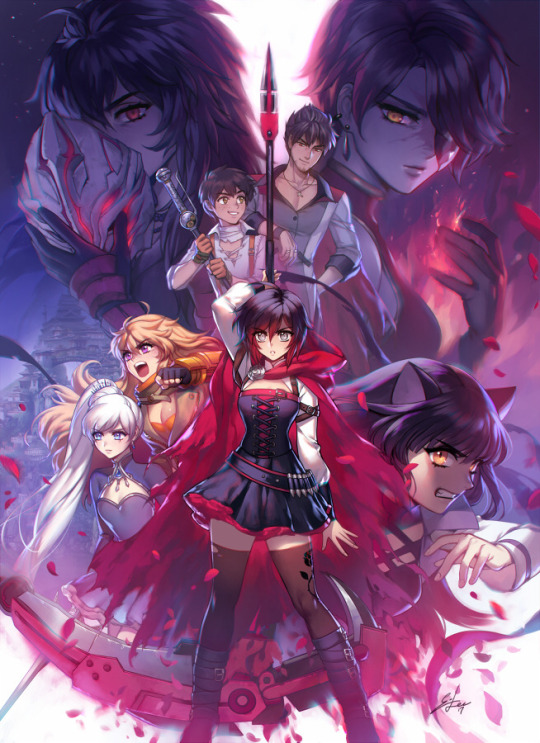
It is when it comes fully into its own a story about pain - abandonment, disaster, political terror and paranoia, endless generational war, oppression, inadequacy, abuse, displacement, long-term emotional trauma, unfair responsibility, and the losses of every stripe of loved one - and how people live with theirs and work to do the right thing and care for one another with that weight bearing on their shoulders, or fail to with monstrous consequences. It actually strikes a very similar chord to me as Kingdom Hearts even if it’s the slightly more ‘grown-up’ take, with its archetypal character templates and old-school fantasy worlds (even if it’s an old-school fantasy world in this case that’s progressed into flying cars and cellphone territory ala latter-day Final Fantasy) and unabashed emotional sincerity. It’s just that for the most part instead of struggling with relatively abstract notions of personhood or literal inner darkness, the people here are outright dealing with death and shame and resentment and uncertainty, even if it’s just as earnest as its counterpart in its belief that those challenges can be overcome, in this case through the power of love or friendship or pride or principles or simple respect for your fellow man or punching a fool with a shotgun blast. Also there are gauntlets that make punches shotgun blasts, and dogs are occasionally fastball specialed at robots, and there’re rock-pop tracks about food fights and fucking up fascists.
So I’d recommend either watching those first two seasons as basically background noise TV or make a marathon night of it, and then give season 3 a real chance to win you over. It’s far from flawless by any metric, but it becomes something really special given time to grow. And don’t forget the little character shorts that go before some of the seasons, they’re not super-important but they do flesh things out.
24 notes
·
View notes
Photo




jessica jones + personality
ARCHETYPE:
INTJ: An Architect is a person with the Introverted, Intuitive, Thinking, and Judging personality traits. These thoughtful tacticians love perfecting the details of life, applying creativity and rationality to everything they do. Their inner world is often a private, complex one. People with this personality type are imaginative yet decisive... ambitious yet like their privacy... curious about everything but remain focused.
TAROT CARDS:
Strength: Upright, Strength, courage, persuasion, influence, compassion. Reversed, Inner strength, self-doubt, low energy, raw emotion
Chariot: Upright, Control, willpower, success, action, determination. Reversed, Self-discipline, opposition, lack of direction.
Judgement: Upright, Judgement, rebirth, inner calling, absolution. Reversed, Self-doubt, inner critic, ignoring the call
ZODIAC:
Sun in Sagittarius: Represented by the archer, Sagittarians are always on a quest for knowledge. The last fire sign of the zodiac, Sagittarius launches its many pursuits like blazing arrows, chasing after geographical, intellectual, and spiritual adventures. Sagittarius is a mutable sign, meaning it is associated with adaptability and flexibility. This perfectly reflects the archers’ deep-rooted desire for change. Sagittarians are born to explore, and it is critical that these archers have the freedom to roam. With Sagittarius, it’s always a wild ride.
Moon in Aquarius: They are quite good observers. They love to analyze human nature. They are usually loners at heart. Their strongest desire is to stay independent. They are cool-headed and detached people. Gemini, Libra, and Aquarius are the most compatible moon signs for Aquarians.
Rising in Scorpio: If you’re a Scorpio rising, you may come off as mysterious, quiet, and alluring. It’s not always a sexually charged charm, although it can be. Most of the time there’s so much going on behind that cool, pristine face, and people want to know more. Rising Scorpios are intense, and you have your reasons. You’ve likely had some experiences that have caused you to put up your guard, especially if you have other Scorpio influence in your chart, and it may take time to get to know you.
template
9 notes
·
View notes